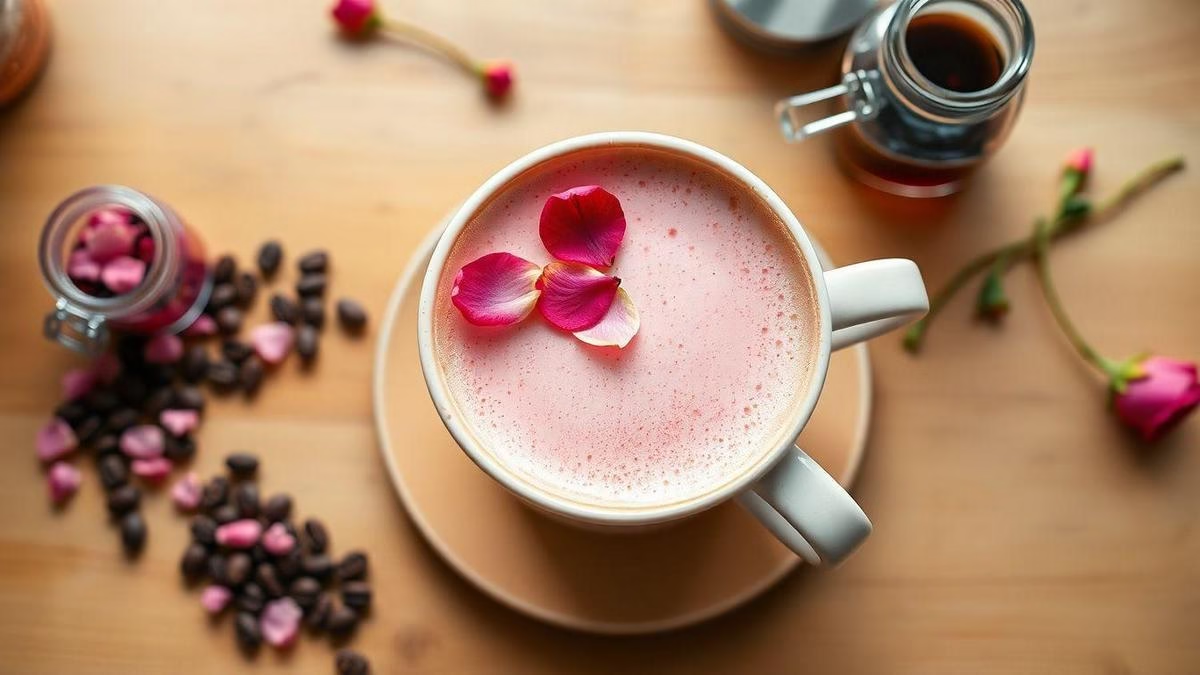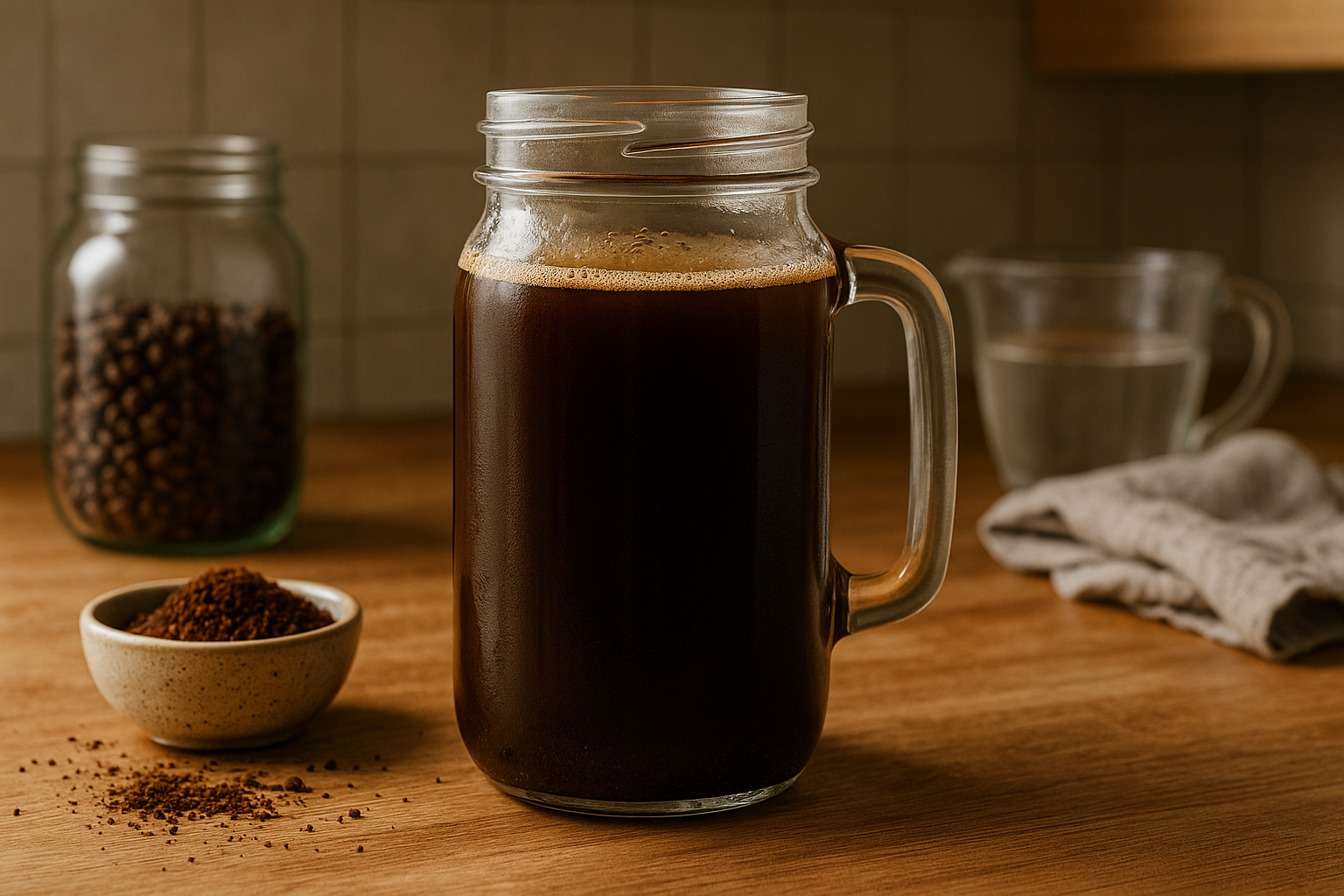How to Make Rose-Flavored Coffee Drink at Home
How to Make Rose-Flavored Coffee Drink at Home helps you craft a cozy floral coffee with simple pantry items and tiny tools. You will learn which coffee base fits your taste, which rose sweeteners and milks pair best, and which edible petals and culinary syrups are safe. You get a quick gear list for filters, espresso, or French press and small helpers like a frother, saucepan, and strainer. Follow an easy method to brew, mix, taste, and tweak sweetness and floral strength. You also get simple rose syrup and petal infusion ideas, tasty latte and iced swaps, and smart safety and storage tips so your rose coffee turns out just right.
Key Takeaway
- Brew coffee you enjoy and make it strong
- Add a little rose syrup or rose water and taste as you go
- Stir in milk or cream to make it smooth for you
- Sweeten the drink to suit your taste
- Garnish your cup with a rose petal or two
Your Ingredients to Make a Homemade Rose Coffee Drink
If you want to learn How to Make Rose-Flavored Coffee Drink at Home, start with a clear ingredient list. Pick a coffee base that matches the floral notes—espresso for a bold hit, or cold brew for a smoother, gentler backdrop. Add a rose element: syrup for sweetness or a few drops of rosewater for aroma. Then choose a milk or creamer that will round out the floral tones without overpowering them.
Think about sweeteners and textures. Simple syrup infused with dried edible petals gives a clean, even sweetness. Honey or condensed milk brings a cozy, dessert-like feel. For texture, steam or froth the milk so the rose perfume sits on a soft cloud; iced drinks benefit from a thicker, creamier milk so the flavor doesn’t get watered down.
Plan your garnish and safety checks. Use only food-grade rose syrup and petals. A few whole petals, a dust of rose sugar, or a tiny spoon of crushed pistachio make the drink look and taste special. Keep measurements small—floral flavors are bold and quick to take over, so add, taste, and adjust.
Tip — always use culinary-grade rosewater or syrup and pesticide-free petals. A little goes a long way.
What coffee base to choose for your rose coffee recipe
Espresso gives you a strong, concentrated canvas; the roasted, slightly bitter notes contrast beautifully with sweet floral syrup. If you like latte-style drinks, espresso allows the rose to sing without getting lost. Pull a double shot, add your syrup, then milk to taste. For detailed brewing methods and ratios, see Specialty Coffee brewing methods and ratios.
If you prefer something milder, go with a medium-strong drip or a cold brew. Cold brew’s smoothness lets the rose come forward gently, great for iced rose coffees. Instant coffee works in a pinch—pick a dark roast instant to keep the balance right.
| Coffee Base | Flavor Impact | Best For |
|---|---|---|
| Espresso | Bold, contrasts floral | Hot lattes, layered drinks |
| Cold brew | Smooth, mellow floral lift | Iced rose coffee |
| Drip/Pour-over | Balanced, clean | Simple hot or iced drinks |
| Instant (dark roast) | Quick, slightly bitter | Fast recipes, diluted syrups |
Which rose sweeteners and milks work best for your homemade rose coffee drink
Rose syrup is the easiest and most reliable sweetener. It adds both sugar and rose aroma in one go. Start with 10–15 ml (about 2–3 teaspoons) for a single drink, then tweak. Rosewater is more potent on aroma and needs just a drop or two; mix it into a simple syrup if you want both sweet and fragrant notes.
For milks, full-fat dairy holds flavor well and foams beautifully. Oat milk is your best non-dairy option—creamy, slightly sweet, and it plays well with floral tones. For a research-backed comparison of plant milks and their properties, check Plant-based milks and dairy alternatives overview. Almond and coconut give distinct flavors that can be lovely if you want a nutty or tropical twist; use them sparingly so they don’t overpower the rose.
A quick rule: less floral, more balance. Add rose slowly and taste after each small change.
Quick checklist of safe edible rose petals and culinary rose syrup
Checklist: use culinary varieties like Damask (Rosa damascena), Centifolia, or Rugosa labelled food-grade; buy organic or pesticide-free petals; choose bottled rose syrup from reputable brands or make your own from food-safe petals and sugar; avoid perfume-treated garden roses and never use petals that might have been sprayed. For more on edible flowers, see this Guide to edible flowers and safety.
Simple Tools You Need to Brew Rose-Flavored Coffee at Home
You don’t need a fancy setup to enjoy rose-flavored coffee. Start with a solid brewing method: drip/filter, espresso, or French press. Each one brings out different notes — bright clarity from a pour-over, concentrated charm from espresso, and full-bodied floral warmth from a press. Pick the method that fits your morning rhythm and taste.
Add a small kit for flavor: rose syrup or rose water, a measuring spoon, and a clean jar for mixing. Keep those concentrates in the fridge so your rose coffee always hits the same note.
Think about a couple of helpers: a thermometer for milk (if you’re making lattes), a scale for repeatable results, and a fine strainer for petals or seeds. These small moves turn good coffee into a memorable cup. If you ever wonder How to Make Rose-Flavored Coffee Drink at Home, these basics get you there without drama.
Basic brewing tools for making rose-flavored coffee at home (filter, espresso, or French press)
A drip or pour-over filter is great when you want clarity. Use a medium grind and pour slowly to let the floral notes shine. Add a teaspoon of rose syrup after brewing, then stir gently so the aroma mixes without overpowering the coffee.
An espresso machine gives you a thick base for lattes and macchiatos. Pull a short, strong shot and add rose syrup to taste. The concentrated espresso balances the sweetness and keeps the floral flavor from feeling like perfume.
A French press is the coziest route. Coarse grounds and longer contact bring a round, heavy body that pairs well with rose-infused milk or syrup. You can steep a small amount of dried rose petals with the grounds, then press and strain for a gentle floral lift.
Small kitchen gear that helps your rose coffee latte recipe (frother, saucepan, strainer)
A milk frother—electric or handheld—whips air into warm milk and carries the rose aroma up into the foam. Add a splash of rose syrup to the milk before frothing for even flavor distribution.
Use a small saucepan to warm milk or to make homemade rose syrup. Heat gently—don’t boil—so the milk stays silky and the syrup keeps its bright taste. A fine mesh strainer catches any petal bits when you transfer syrup or infused milk to your cup.
A tight strainer keeps textures smooth. If you steep petals or seeds, pour through the strainer into a jar. This step keeps your drink clean and lets the rose scent come through without stray bits.
One-minute setup tip to keep your tools clean and ready
Right after you finish your cup, rinse the main parts: carafe, portafilter, frother head, and strainer. A quick rinse and a wipe take about a minute and prevents sticky syrup or milk film from building up.
Tip: Keep a small tray or basket by your coffee station for the few tools you use every day. It saves time and keeps your routine flowing like a well-tuned kettle.
How to Make Rose-Flavored Coffee Drink at Home — Step-by-Step Method
You can make a floral, cozy coffee that feels like a small celebration. Start by choosing a coffee base you like: a single shot of espresso for intensity, a strong pour-over for clarity, or a concentrated French press if you don’t have an espresso machine. Gather whole milk or barista oat milk, rose syrup (store-bought or homemade), a frother or small whisk, and a spoon. This guide shows you How to Make Rose-Flavored Coffee Drink at Home with clear steps so you don’t overshoot the floral notes.
Once the coffee is ready, warm the milk gently and create microfoam if you want a latte-style drink. Heat milk to about 60–65°C (140–150°F) and froth until silky. Measure your rose syrup: start small. The rose flavor is strong and a little goes a long way. Pour coffee into your cup, add syrup, then milk, stirring gently so the layers blend but the aroma stays alive.
Taste as you go. Floral notes can sit differently on your tongue than sweet syrupy flavors. Sip between steps and tweak small amounts rather than big swigs. Some days you might want a hint of rose like a whisper; other times you’ll want a bright, floral headline. Keep tasting and adjusting.
How to brew and mix your coffee, milk, and rose syrup for a balanced drink
If you have an espresso machine, pull a 25–30 second shot. For pour-over, use a coffee-to-water ratio around 1:15 and brew slightly stronger than usual. For French press, use a 1:12 ratio and steep 3.5–4 minutes. Strong coffee keeps the rose from becoming cloying. Use medium-dark beans if you like the floral to play against chocolatey notes; light roasts make the rose pop more.
Mixing order matters. Add rose syrup to the cup first, pour coffee over it and stir to dissolve the syrup into the hot liquid. Then add warmed milk and finish with foam. For iced recipes, cool the coffee first, then stir in the syrup over ice and top with cold milk. Small changes in temperature and order change how the rose aroma reaches your nose, so follow the sequence until you find your sweet spot.
Tip: Start with 5–10 ml of rose syrup for a 250 ml drink. Add 5 ml at a time after tasting until it sings.
| Coffee base | Coffee amount | Milk amount | Rose syrup (start) | Notes |
|---|---|---|---|---|
| Espresso latte | 30–45 ml | 180–200 ml | 5–10 ml | Bold and balanced |
| Pour-over strong | 120–150 ml | 100–130 ml | 8–12 ml | Clear coffee flavor |
| Iced rose latte | 120 ml cold brew | 120 ml cold milk | 8–15 ml | Chill first, then mix |
How to taste and adjust sweetness, rose strength, and milk foam while making rose coffee at home
Taste in small sips and think of three things: aroma, sweetness, and mouthfeel. If the rose smells too strong, add more coffee or a splash of milk to anchor it. If it’s too subtle, add 3–5 ml of syrup and taste again. For sweetness control, swap part of the rose syrup for a neutral sweetener like simple syrup or honey — that keeps floral strength without extra perfume.
For foam, look for glossy microfoam that clings to the milk’s surface. If foam breaks up quickly, the milk was overheated or under-aerated. Try a different milk with higher protein (whole milk or barista oat) or a second quick swirl with your frother. If the drink tastes flat, a tiny pinch of salt or a drop of lemon to the coffee before adding milk can brighten the cup and make the rose feel fresher.
Simple timing guide so your rose floral coffee recipe stays consistent
Pull espresso for 25–30 seconds, steep French press 3.5–4 minutes, heat and froth milk for 30–45 seconds, and stir syrup into hot coffee for 5–10 seconds. For iced drinks, chill coffee 10–15 minutes before mixing. Keep a short rhythm: brew, syrup, stir, milk, foam — repeat the same timing and ratios until the drink matches your memory.
How to Make Rose Syrup and a Rose Petal Coffee Infusion
You can make a rose-flavored coffee that feels fancy without fancy gear. If you want to learn How to Make Rose-Flavored Coffee Drink at Home, start with two simple ideas: a sweet rose syrup to sweeten and scent, and a gentle petal infusion to add floral notes to brewed coffee. Both paths are quick and let you control how strong the rose comes through.
The syrup gives you consistent flavor and sweetness. It mixes straight into espresso, americano, latte, or iced coffee. The infusion is subtler — it layers floral scent without turning the cup into perfume. You’ll choose syrup when you want sweetness and a steady rose tone, and infusion when you want a whisper of petals.
Pick food-grade rose water or petals from a trusted seller. Wild or garden petals can carry pesticides or bitter bits. Work small at first: you can always add more rose but you can’t take it away. Taste as you go and keep the floral note light.
Easy rose syrup for coffee: sugar, water, and food-grade rose water or petals
Start with a basic simple syrup: equal parts sugar and water. Heat 1 cup water with 1 cup sugar until the sugar dissolves, then add either 1 tablespoon food-grade rose water or a small handful (about 1/4 cup) of fresh edible rose petals. Turn off the heat and let the mixture steep for 15–30 minutes so the rose aroma infuses the syrup without cooking away the scent. Strain and cool before you use it.
Store the syrup in the fridge in a clean jar. Use about 1–2 teaspoons per cup of coffee to start. Adjust to taste. If you use dried rose petals, reduce steep time and check flavor sooner — dried petals can hit stronger. This syrup works great in hot drinks and iced drinks alike.
| Ingredient | Small batch (approx.) | Notes |
|---|---|---|
| Water | 1 cup | Use filtered if possible |
| Granulated sugar | 1 cup | Brown sugar will change color and flavor |
| Food-grade rose water | 1 tbsp OR | Strong and clear rose flavor |
| Fresh edible rose petals | 1/4 cup (optional) | Use only food-grade petals |
Tip: Use food-grade rose ingredients only. A little rose goes a long way — start small and taste.
How to make a rose petal coffee infusion for a light floral note without overpowering the coffee
For a delicate infusion, steep petals separately and add a little of that floral water to your brewed coffee. Put 1–2 teaspoons of fresh petals in 1 cup hot water, steep 5–8 minutes, then strain. Add just a splash to a cup of coffee. This method gives scent without adding sugar, so you control sweetness separately.
If you prefer to infuse directly with your grounds, add a teaspoon of petals per 12 ounces of coffee in a French press or drip brewer and cut the steep time by a minute or two. Taste early. Floral notes can become soapy if you overdo them, so less is more. Cold-brew lovers can add petals to the grounds for a mild, round finish — try 1 tablespoon petals per 12 oz of grounds and steep 12–18 hours.
Safe cooling and straining steps to store your rose syrup for coffee
After steeping, let the syrup cool to room temperature, then strain through a fine mesh sieve or cheesecloth to remove tiny petal bits. Pour into a sterilized glass bottle and refrigerate. The syrup will last about two weeks in the fridge; add a splash of vodka or a teaspoon of citric acid if you want to extend the shelf life.
Easy Variations: How to Make Rose Latte, Iced Rose, and Other Recipes
If you want to learn How to Make Rose-Flavored Coffee Drink at Home, this is your quick playground. Start with a bold espresso or strong brewed coffee. Add a floral twist with rose syrup or a few drops of rosewater. You’ll be surprised how a tiny splash changes the whole mood of your cup.
Treat rose coffee like a mood ring: bright and sweet for sunny mornings, soft and warm for slow afternoons. Balance is the trick — floral notes can go from charming to soapy if you overdo them. Measure with teaspoons at first and taste as you go.
Try small experiments: espresso versus drip, dairy versus plant milk, syrup versus rosewater. Keep notes on what you like. That way you build a recipe that feels like yours.
How to make rose latte using espresso, steamed milk, and rose syrup or rosewater
Pull a single or double shot of espresso. While it’s hot, stir in 1–2 teaspoons of rose syrup or 2–3 drops of rosewater. Steam 6–8 oz of milk until it’s silky. Pour the milk over the espresso slowly to keep a creamy texture. Taste and add a little more syrup if you want it sweeter.
If you use rosewater, add less at first — it’s more concentrated. Rose syrup adds both flavor and body because it has sugar. Mix a half-teaspoon of vanilla with the syrup for a bakery-style twist. Serve right away so the aroma stays bright.
Iced rose-flavored coffee at home and vegan swaps for your DIY rose coffee drink
Brew coffee double-strong and let it cool. Fill a glass with ice, add 1–2 teaspoons rose syrup, pour coffee over, then top with oat milk or almond milk. Stir and taste. For a creamier drink, use cold foam made from chilled oat milk. The cold highlights floral notes differently than hot drinks, so start light.
Vegan swaps are easy. Oat milk gives a silky mouthfeel and pairs well with floral flavors. Almond or soy add nuttiness. If you want the syrup without sugar, use a low-calorie rose syrup or make one at home with monk fruit sweetener. A dash of lemon can brighten the drink if it feels too heavy.
| Drink | Coffee base | Rose amount | Milk & swaps |
|---|---|---|---|
| Rose Latte (hot) | 1–2 shots espresso | 1–2 tsp syrup or 2–3 drops rosewater | 6–8 oz steamed whole or oat milk |
| Iced Rose Coffee | Strong brewed coffee | 1–2 tsp syrup | Ice oat/almond/soy milk |
| Vegan foam | Cold oat milk | — | Blend cold to foam for topping |
“A single floral note can turn your coffee into a tiny celebration.”
Safety, Storage, and Smart Tips for Making Rose Coffee at Home
Before you brew, think about safety and flavor. Roses can carry pesticides, dust, or soap from handling. Use only culinary-grade roses or organic petals sold for food, and rinse them gently. If you want to learn How to Make Rose-Flavored Coffee Drink at Home, start with clean flowers and clean hands.
Work clean and stay picky with ingredients. Use filtered water for infusions and make syrups in a sanitized pot. If you make rose syrup, cool it quickly and move it to the fridge to slow bacterial growth. Small steps like clean jars and tight lids make a big difference in taste and safety.
Taste matters and so does balance. Start light with rose and adjust. Too much can taste soapy. Keep records: note how many petals or teaspoons you used, and how long you infused. That way you repeat what you like and avoid surprises next time.
Check for allergies and use culinary-grade roses when making rose-flavored coffee at home
Some people react to roses. If you or anyone drinking your coffee has pollen or plant allergies, do a small skin test first: touch a tiny bit of rose syrup to your wrist and wait an hour. For clinical guidance on pollen-related reactions and testing, see Pollen allergy symptoms and testing guidance. If you get redness or itching, stop. Better safe than sorry.
Only use petals labeled for culinary use or organic roses you grew without chemicals. Garden roses sprayed with pesticides are not safe to eat. If you buy petals, check the label. If you pick your own, wash them well and remove any green parts.
How to store rose syrup, infused coffee, and prepared rose lattes safely in the fridge
Store rose syrup in a clean, airtight jar. Syrup with lots of sugar will last longer—usually up to two weeks in the fridge. If you use less sugar or add dairy later, shorten that time. Keep the jar cold and use a clean spoon each time to avoid contamination. For official refrigerator temperature and storage guidance, consult Safe refrigerator storage and temperatures.
For rose-infused coffee concentrate, chill it quickly and use within 3–4 days. Prepared rose lattes with milk should be treated like any milk drink: drink within 24–48 hours and always check smell and texture before sipping. Label jars with the date so you don’t guess.
Tip: Label jars with the date and contents. If anything smells off or looks cloudy, toss it.
| Item | Fridge time | Best temp | Quick notes |
|---|---|---|---|
| Rose syrup (high sugar) | Up to 14 days | 1–4°C (34–39°F) | Use clean spoon; tight lid |
| Rose-infused coffee | 3–4 days | 1–4°C (34–39°F) | Strain well; keep sealed |
| Prepared rose latte (dairy) | 24–48 hours | 1–4°C (34–39°F) | Smell test before drinking |
Simple calorie and sugar note so you can control sweetness when making rose coffee at home
A tablespoon of rose syrup can add about 50–60 calories and 12–15 grams of sugar. If you cut syrup to one teaspoon, you slash calories and keep the floral note. Use unsweetened plant milk or dilute syrup with more coffee if you want flavor without the sugar hit.
Conclusion
You can make a charming, floral coffee at home with a few smart choices and gentle tweaks. Start with a coffee base you love—espresso for boldness or cold brew for a mellow lift—then add rose syrup or a drop of rosewater, tasting as you go. Use only food-grade petals, start small, and remember that a little goes a long way; let the rose whisper, not shout. Keep your tools clean, chill and label syrups, and treat timings and ratios like a dimmer switch for flavor. With a few tries you’ll find a recipe that feels like yours. Want more ideas and easy recipes? Read more articles at https://guiabebefeliz.com.

Rafael Souza is a digital marketing specialist and passionate coffee enthusiast. He founded Guiabebefeliz to share practical, easy-to-follow guides for making great coffee at home without needing professional barista skills. His mission is to help readers enjoy better coffee experiences, one cup at a time.






